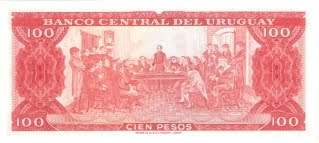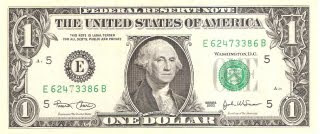Thailand 20 Baht 1981 VF
Front: King Rama IX
Back: Taksin
An Educational portal with various pictures of banknotes and information. All the banknotes on this site is exclusive property of Encyclobanknotes.
Friday, March 26, 2010
Thursday, March 25, 2010
Sri Lanka
Sri Lanka 10 Rupees 2001 VG
Front: Sinhalese Chinthe
Back: Presidential Secretariat building in Colombo
Front: Sinhalese Chinthe
Back: Presidential Secretariat building in Colombo
Sri Lanka
Sri Lanka 20 Rupees 2001 UNC
Front: Garuda (destroyer of snakes)
Back: Fishermen; sea shells
The Garuda is a large mythical bird or bird-like creature that appears in both Hindu and Buddhist mythology. From an Indian perspective, Garuda is the Hindu name for the constellation Aquila and the Brahminy kite is considered to be the contemporary representation of Garuda. Other nations adopt a more stylistic approach to the Garuda's depiction, where it depicts an eagle. In Hindu mythology, Garuda is a lesser Hindu divinity, usually the mount (vahanam) of Vishnu. The story of Garuda's birth and deeds is told in the first book of the great epic Mahabharata. According to the epic, when Garuda first burst forth from his egg, he appeared as a raging inferno equal to the cosmic conflagration that consumes the world at the end of every age. Frightened, the gods begged him for mercy. Garuda, hearing their plea, reduced himself in size and energy. Also according to the Mahabharata, Garuda had six sons from whom were descended the race of birds. In Buddhist mythology, the garuḍas (Pāli: garuḷā) are enormous predatory birds with intelligence and social organization. Another name for the garuḍa is suparṇa (Pāli: supaṇṇa), meaning "well-winged, having good wings". Like the Nāgas, they combine the characteristics of animals and divine beings, and may be considered to be among the lowest devas. Read more
Garuda, the Vahana of Lord Vishnu
Information and Image Obtained From Wikipedia, the free encyclopedia
Front: Garuda (destroyer of snakes)
Back: Fishermen; sea shells
The Garuda is a large mythical bird or bird-like creature that appears in both Hindu and Buddhist mythology. From an Indian perspective, Garuda is the Hindu name for the constellation Aquila and the Brahminy kite is considered to be the contemporary representation of Garuda. Other nations adopt a more stylistic approach to the Garuda's depiction, where it depicts an eagle. In Hindu mythology, Garuda is a lesser Hindu divinity, usually the mount (vahanam) of Vishnu. The story of Garuda's birth and deeds is told in the first book of the great epic Mahabharata. According to the epic, when Garuda first burst forth from his egg, he appeared as a raging inferno equal to the cosmic conflagration that consumes the world at the end of every age. Frightened, the gods begged him for mercy. Garuda, hearing their plea, reduced himself in size and energy. Also according to the Mahabharata, Garuda had six sons from whom were descended the race of birds. In Buddhist mythology, the garuḍas (Pāli: garuḷā) are enormous predatory birds with intelligence and social organization. Another name for the garuḍa is suparṇa (Pāli: supaṇṇa), meaning "well-winged, having good wings". Like the Nāgas, they combine the characteristics of animals and divine beings, and may be considered to be among the lowest devas. Read more
Garuda, the Vahana of Lord Vishnu
Information and Image Obtained From Wikipedia, the free encyclopedia
Sri Lanka, Sacred City of Anuradhapura, UNESCO World Heritage Site


Sri Lanka 50 Rupees 2004 P
Front: Guard stone from an entrance steps of a
stupa in Anuradhapura; Native male dancer with local headdress
Back: Temple ruins; Stupa in Anuradhapura; Ornamental sword hilt
Encycloworld Heritage Postcard - Sacred City of Anuradhapura
Anuradhapura, (அனுராதபுரம் in Tamil), is one of the ancient capitals of Sri Lanka, famous for its well-preserved ruins of ancient Lankan civilization.
The city, now a UNESCO World Heritage Site, lies 205 km north of the current capital Colombo in Sri Lanka's North Central Province, on the banks of the historic Malvathu Oya.
From the 4th century BC, it was the capital of Sri Lanka until the beginning of the 11th century AD. During this period it remained one of the most stable and durable centers of political power and urban life in South Asia. The ancient city, considered sacred to the Buddhist world, is today surrounded by monasteries covering an area of over sixteen square miles (40 km²). Read more
Information and Image Obtained From Wikipedia, the free encyclopedia
Sri Lanka, Ancient City of Sigiriya, UNESCO World Heritage Site

Sri Lanka 100 Rupees 2004 UNC
Front: Decorative urn
Back: Sigiriya Rock
Sigiriya (Lion's rock) is an ancient rock fortress and palace ruin situated in the central Matale District of Sri Lanka, surrounded by the remains of an extensive network of gardens, reservoirs, and other structures. Sigiriya is also renowned for its ancient paintings (frescos), which are reminiscent of the Ajanta Caves of India. The Sigiriya was built during the reign of King Kassapa I (AD 477 – 495), and it is one of the seven World Heritage Sites of Sri Lanka. Sigiriya may have been inhabited through prehistoric times. It was used as a rock-shelter mountain monastery from about the 5th century BC, with caves prepared and donated by devotees to the Buddhist Sangha. Read more
Information Obtained From Wikipedia, the free encyclopedia
Encycloworld Heritage Postcard - Ancient City of Sigiriya
Wednesday, March 24, 2010
Tajikistan
Tajikistan 20 Dirams 1999 UNC
Front: Meetings Hall of the National Bank of Tajikistan
Back: Mountain road
Tuesday, March 23, 2010
Monday, March 22, 2010
Tuesday, March 9, 2010
Philippine
The Bangko Sentral ng Pilipinas has stopped printing this banknote, and it is currently being replaced by equivalent coins. However, existing banknotes remain legal tender.


Philippine 5 Piso 1985-1994 Poor
Front: Emilio Aguinaldo.
Back: Declaration of independence by Emilio Aguinaldo on June 12, 1898.
Emilio Aguinaldo y Famy(March 22, 1869 – February 6, 1964) was a Filipino general, politician, and independence leader of Chinese and Spanish descent. He played an instrumental role in Philippine independence during the Philippine Revolution against Spain and the Philippine-American War that resisted American occupation. He eventually pledged his allegiance to the US government.
In the Philippines, Aguinaldo is considered to be the country's first and the youngest Philippine President. Read more


Philippine 5 Piso 1985-1994 Poor
Front: Emilio Aguinaldo.
Back: Declaration of independence by Emilio Aguinaldo on June 12, 1898.
Emilio Aguinaldo y Famy(March 22, 1869 – February 6, 1964) was a Filipino general, politician, and independence leader of Chinese and Spanish descent. He played an instrumental role in Philippine independence during the Philippine Revolution against Spain and the Philippine-American War that resisted American occupation. He eventually pledged his allegiance to the US government.
In the Philippines, Aguinaldo is considered to be the country's first and the youngest Philippine President. Read more
Monday, March 8, 2010
Pakistan, Archaeological Ruins at Mohenjo-daro, UNESCO World Heritage Site


Pakistan 10 Rupees 1976 VF
Front: Muhammad Ali Jinnah
Back: Mohenjo-daro in Larkana District
Mohenjo-daro was one of the largest city-settlements of the Indus Valley Civilization of south Asia situated in the province of Sindh, Pakistan. Built around 2600 BCE, the city was one of the early urban settlements in the world, existing at the same time as the civilizations of ancient Egypt, Mesopotamia, and Crete. The archaeological ruins of the city are designated a UNESCO World Heritage Site. It is sometimes referred to as "An Ancient Indus Valley Metropolis"
Information and Image Obtained From Wikipedia, the free encyclopedia
Pakistan, before the 2005 Series


Pakistan 100 Rupees 1976 VF
Front: Muhammad Ali Jinnah
Back: Islamia College in Peshawar
Muhammad Ali Jinnah (December 25, 1876 – September 11, 1948), a 20th century politician and statesman, is regarded as the founder of Pakistan. He served as leader of The Muslim League and Pakistan's first Governor-General. He is officially known in Pakistan as Quaid-i-Azam and Baba-e-Qaum ("Father of the Nation"). His birthday is a national holiday in Pakistan. Jinnah rose to prominence in the Indian National Congress initially expounding ideas of Hindu-Muslim unity and helping shape the 1916 Lucknow Pact between the Muslim League and the Indian National Congress; he also became a key leader in the All India Home Rule League. He proposed a fourteen-point constitutional reform plan to safeguard the political rights of Muslims in a self-governing India.
Jinnah, advocating the Two-Nation Theory, embraced the goal of creating a separate state for Muslims as per the Lahore Resolution. The League won most reserved Muslim seats in the elections of 1946. After the British and Congress backed out of the Cabinet Mission Plan Jinnah called for a Direct Action Day to achieve the formation of Pakistan. The direct action by the Muslim League and its Volunteer Corps, resulted in massive rioting in Calcutta between Muslims and Hindus/Sikhs. As the Indian National Congress and Muslim League failed to reach a power sharing formula for united India, it prompted both the parties and the British to agree to independence of Pakistan and India. As the first Governor-General of Pakistan, Jinnah led efforts to rehabilitate millions of refugees, and to frame national policies on foreign affairs, security and economic development. He died a year after Pakistan's formation in September 1948. Read more
Information and Image Obtained From Wikipedia, the free encyclopedia
Korea, 1992 Series


Korea 1 Won 1992 UNC
Front: Young woman with flowers
Back: Mount Kumgang
There are many old temples around Kŭmgangsan, some in poor condition. Among the best known are Changan-sa and Maha-yon. Other features include: Sea Manmulsang, Kŭmgang Gate, Samil Lagoon, Piro Peak, the Manpok ravine, Myongyong rock, the Paektap ravine, Manmulsang, Kuryong pond, the pools of Upper Pal, Sujong Peak, Ongnyu ravine, the Hanha Stream, and the Sibi waterfalls.
Friday, March 5, 2010
Korea, 1992 Series


Korea, North 100 Won 1992 UNC
Front: Kim Il-sung
Back: Kim Il Sung's birthplace in Mangyongdae-guyok
Kim Il-sung (15 April 1912 – 8 July 1994) was a Korean communist politician who led North Korea from its founding in 1948 until his death. He held the posts of Prime Minister from 1948 to 1972 and President from 1972 to his death. He was also the General Secretary of the Workers Party of Korea.
During his tenure as leader of North Korea, he ruled the nation with autocratic power and established an all-pervasive cult of personality. From the mid-1960s, he promoted his self-developed Juche variant of communist national organisation. Following his death in 1994, he was succeeded by his son Kim Jong-il. North Korea officially refers to Kim Il-sung as the "Great Leader" (Suryong in Korean) and he is designated in the constitution as the country's "Eternal President". His birthday is a public holiday in North Korea. Read more
Subscribe to:
Posts (Atom)
























